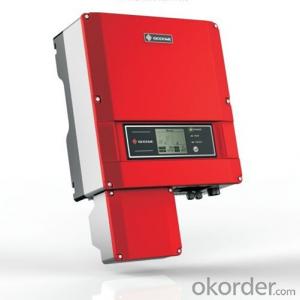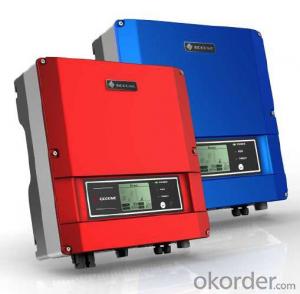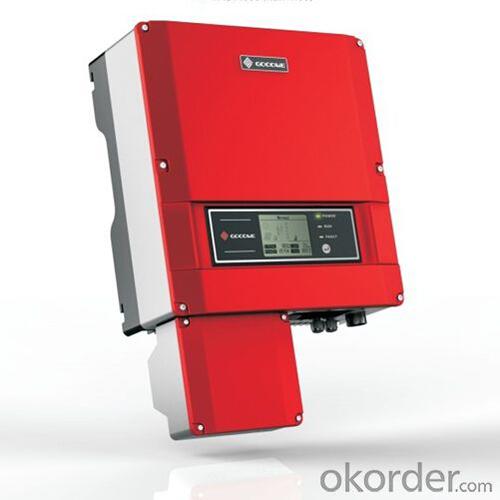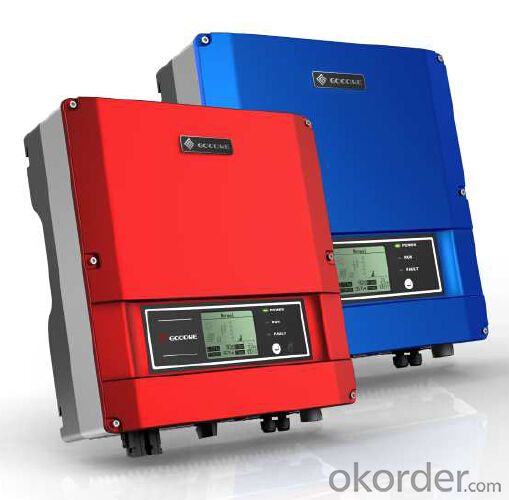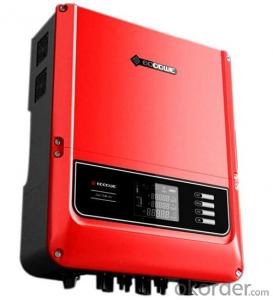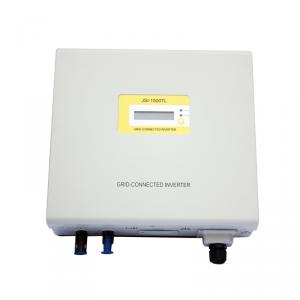15 Kw Solar Inverter GW3600D-DI (High Frequency Isolated)
- Loading Port:
- Shanghai
- Payment Terms:
- TT OR LC
- Min Order Qty:
- 12 pc
- Supply Capability:
- 1000 pc/month
OKorder Service Pledge
OKorder Financial Service
You Might Also Like
GW3000/3600/4200D-DI (High Frequency Isolated)
1.SPECIFATION
is the new on-grid PV inverter which integrated with most advanced technology, come with 10 years warranty,
and are designed to meet the new IEE1547 requirements for the North American market. Also it’s suitable for thick-film modules.
Easy installation and simple operation make them ideal for residential and small-to-medium commercial applications.
GoodWe inverters, with ever-increasing efficiency and high stability,
could ensure you better overall performance of solar power systems and shorter payback periods.
2.Datasheet
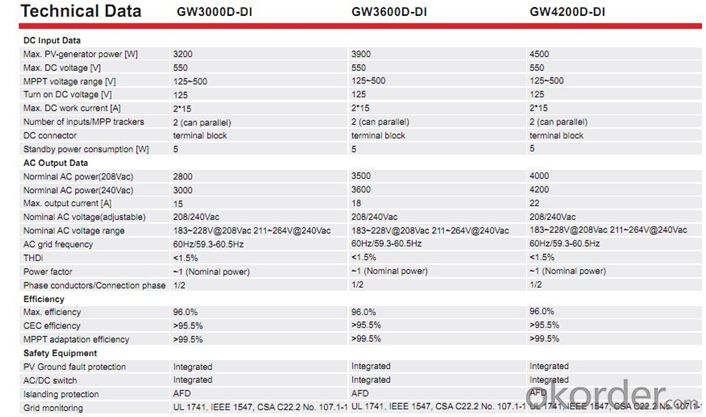
3. Solar inverter certification
EN 61000
VDE 0126-1-1
C10/11
G83/2
UTE C15-712-1
AS4777
CQC
CE10-21
EN50438
4.solar inverter picture
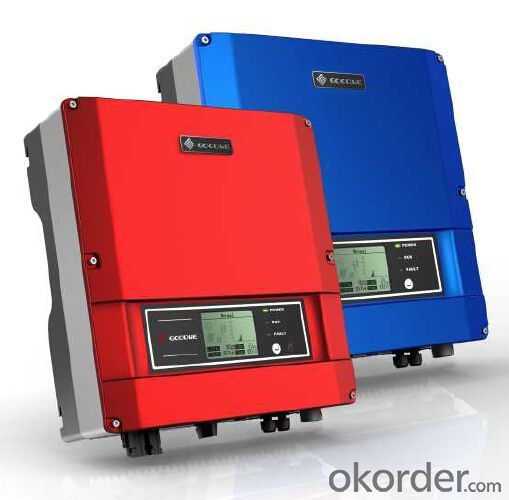
FAQ
1. What price for each watt?
It depends on the efficiency of the solar cell, quantity, and delivery date and payment terms.
2. How long can we receive the product after purchase?
In the purchase of product within three working days, We will arrange the factory delivery as soon as possible. The pacific time of receiving is related to the state and position of customers. Commonly 7 to 10 working days can be served.
We can provide you not only the solar material but also the off grid solar system, we can also provide you service with on grid plant.
4. How do you pack your products?
We have rich experience on how to pack the solar cell to make sure the safety on shipment; we could use wooden box or pallet as buyer's preference.
5. Can you do OEM for us?
Yes, we can.
- Q: Can a solar inverter be integrated with smart home systems?
- Yes, a solar inverter can be integrated with smart home systems. Smart home systems allow for the monitoring and control of various devices and appliances in a home, and a solar inverter can be integrated into this system to provide real-time data on solar energy production, as well as the ability to remotely control and optimize the solar power usage in the home.
- Q: How do you choose the right size solar inverter for a specific solar power system?
- To ensure optimal performance and efficiency of your solar power system, careful consideration of various factors is necessary when selecting the appropriate size solar inverter. Follow these steps to make the right choice: 1. Calculate your solar power system's total capacity: Begin by determining the combined wattage of all your solar panels. This information can typically be found in the product specifications or obtained from your solar panel manufacturer. 2. Evaluate your average energy consumption: Assess your typical energy consumption to determine the size of the solar inverter required to meet your needs. Take into account peak power usage and potential future increases in energy demands. 3. Match the inverter's capacity with your system's: Ensure that the solar inverter's capacity is equal to or slightly higher than your system's total capacity to achieve optimal performance. 4. Consider the inverter's efficiency: Seek out an inverter with high efficiency ratings. A higher efficiency rating means it can convert a larger percentage of solar energy into usable electricity, minimizing power losses. 5. Select the appropriate inverter type: Decide which type of solar inverter is suitable for your system. The three main types are string inverters, microinverters, and power optimizers. String inverters are the most common and cost-effective choice for small to medium-sized systems, while microinverters and power optimizers are better suited for complex installations or systems with shading issues. 6. Assess additional features: Take into account any additional features offered by the solar inverter. Look for features like monitoring capabilities, grid integration capabilities, and built-in safety features such as arc fault protection or rapid shutdown. 7. Seek professional advice: If you are uncertain about selecting the right size solar inverter for your specific solar power system, consulting a professional solar installer or electrical engineer is advisable. They can help assess your energy needs, system requirements, and provide expert guidance in choosing the appropriate inverter size. Remember, making an informed decision when choosing the right size solar inverter is crucial for your system's overall performance and efficiency. Take the time to evaluate your system's requirements and seek expert advice to ensure the best outcome.
- Q: How does a solar inverter handle variations in solar irradiation?
- A solar inverter handles variations in solar irradiation by continuously monitoring the amount of sunlight received from the solar panels. It adjusts its power output accordingly to convert the maximum available DC power from the panels into AC power for use in the electrical grid or home. This dynamic response ensures that the inverter optimizes energy production even during changing weather conditions or fluctuations in solar irradiation.
- Q: What is the role of a solar inverter in reactive power compensation?
- To regulate and control the flow of reactive power in a solar power system, a solar inverter plays a crucial role in reactive power compensation. The presence of inductive or capacitive elements in the system causes reactive power to oscillate between the source and load. Although this power does not contribute to the actual work done by the system, it is necessary for the operation of specific devices. A solar inverter, specifically designed for reactive power compensation, is capable of measuring the reactive power in the system and adjusting its operation accordingly. It has the ability to generate or absorb reactive power as needed to maintain a power factor close to unity. The power factor is a measure of the efficiency of electrical energy utilization, and a high power factor indicates efficient electricity usage. By compensating for reactive power, a solar inverter ensures that the solar power system operates at optimal efficiency. It alleviates the burden on the grid by locally supplying or absorbing reactive power instead of relying on the grid for compensation. This not only improves the overall quality of power but also reduces system losses. Furthermore, it helps stabilize voltage levels and minimize voltage fluctuations, which can be advantageous for delicate electrical equipment. In conclusion, the role of a solar inverter in reactive power compensation is vital for regulating the flow of reactive power in a solar power system, maintaining a high power factor, and improving overall system efficiency. It plays a pivotal role in ensuring the optimal operation of the solar power system and diminishing the dependence on the grid for reactive power compensation.
- Q: What happens to excess solar energy generated by the inverter?
- Excess solar energy generated by the inverter can be either stored in batteries for later use or fed back into the electrical grid, depending on the setup of the solar power system.
- Q: Can a solar inverter be used in a solar-powered street lighting system?
- Yes, a solar inverter can be used in a solar-powered street lighting system. A solar inverter is responsible for converting the direct current (DC) produced by solar panels into alternating current (AC) that can be used to power the street lights. Therefore, it plays a vital role in ensuring that solar energy is efficiently utilized in the lighting system.
- Q: Can a solar inverter be used with a generator as a backup power source?
- Yes, a solar inverter can be used with a generator as a backup power source. The solar inverter can be connected to the generator's power output, allowing it to convert the generator's AC power into usable DC power for the solar panels. This enables the solar panels to continue generating electricity even when there is no sunlight, providing a reliable backup power supply.
- Q: What are the key safety features to look for in a solar inverter?
- The key safety features to look for in a solar inverter include: 1. Overvoltage and undervoltage protection: This feature ensures that the inverter can handle voltage fluctuations and prevents damage to the electrical system. 2. Ground fault protection: It is essential for the inverter to have ground fault protection to prevent electric shocks and ensure the safety of the system. 3. Anti-islanding protection: This feature ensures that the solar inverter shuts down in the event of a power outage, preventing it from sending power back to the grid and endangering utility workers. 4. Overtemperature protection: A reliable solar inverter should have overtemperature protection to prevent overheating and potential fire hazards. 5. Surge protection: The inverter should have built-in surge protection to safeguard against power surges caused by lightning strikes or grid fluctuations. 6. Arc fault protection: This safety feature detects and mitigates the risk of arc faults, which can result in electrical fires, by rapidly shutting down the inverter. 7. Monitoring and fault detection: A good solar inverter should have a monitoring system that detects faults or abnormalities in real-time, allowing for prompt maintenance and troubleshooting. 8. Compliance with safety standards: Ensure that the solar inverter complies with relevant safety standards, such as UL (Underwriters Laboratories) or IEC (International Electrotechnical Commission), to guarantee its safety and reliability. By considering these key safety features, you can ensure the overall safety and performance of your solar inverter system.
- Q: How does a solar inverter communicate with monitoring systems?
- A solar inverter communicates with monitoring systems through various communication protocols such as Wi-Fi, Ethernet, or cellular networks. These protocols allow the inverter to send real-time data regarding the system's performance, including power output, voltage, and current, to the monitoring system. This data is then analyzed and displayed on a monitoring platform or app, providing insights into the solar system's overall efficiency, energy production, and any potential issues or faults.
- Q: How does a solar inverter handle voltage dip and interruption?
- A solar inverter handles voltage dip and interruption by continuously monitoring the incoming grid voltage. In case of a voltage dip, it utilizes its internal control mechanisms to stabilize and regulate the output voltage, ensuring a consistent power supply to the connected solar panels. In the event of a complete interruption of grid power, the inverter quickly switches to an off-grid mode, where it utilizes the solar energy stored in batteries (if available) to continue powering the connected loads. This way, it effectively mitigates the impact of voltage fluctuations and interruptions, ensuring uninterrupted power supply from the solar panels.
Send your message to us
15 Kw Solar Inverter GW3600D-DI (High Frequency Isolated)
- Loading Port:
- Shanghai
- Payment Terms:
- TT OR LC
- Min Order Qty:
- 12 pc
- Supply Capability:
- 1000 pc/month
OKorder Service Pledge
OKorder Financial Service
Similar products
Hot products
Hot Searches
Related keywords
